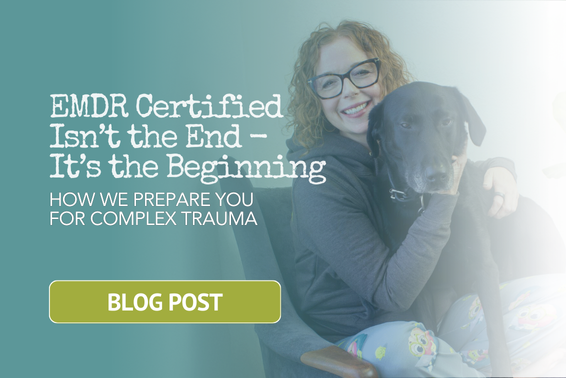
What if Symptoms Make Sense?
The Hidden Genius of Anxiety, Depression, and More in Complex Trauma
Written by Susie Morgan, LMFT, BCETS - July 6, 2025
Reframing Symptoms as Affect-Management Strategies
It’s the gentle exploration of what lies beneath the surface, understanding that even challenging symptoms have purpose.
Shifting perspective to approach symptoms like anxiety, depression, and anger with curiosity—rather than pathologizing judgment—reveals them as intelligent strategies developed early in life in response to Complex Developmental Trauma.
Conditions historically labeled as mental illness might better be understood as illustrating the innate wisdom of individuals' nervous systems, designed to manage overwhelming emotions from traumatic environments and unmet attachment needs.
Why Traditional Diagnoses Fall Short
It’s recognizing how adaptive childhood survival strategies evolve into the symptoms we experience as adults.
Traditional diagnostic categories can mislead clinicians by obscuring trauma's role. Research, including studies cited in APA’s recent guidelines for CPTSD and studies on Adverse Childhood Experiences (ACEs), consistently identifies Complex Trauma as a core driver of symptoms across diagnoses.
This insight is particularly compelling when considering how the paradoxical approaches of expert therapists like David Burns (2020) and Jim Knipe (2018) converge despite being from the markedly different theoretical camps of Cognitive Behavioral and EMDR Therapies. They both suggest that if the question is asked, "What would be lost if this symptom disappeared?" the strategic roots of seemingly problematic behaviors become clear.
Childhood: The Origin of Strategic Symptoms
It’s understanding that these strategies emerged from necessity, where survival depended on creative adaptations.
Childhood can be experienced as captivity, especially in frightening or neglectful environments. Powerful emotions—fear, sadness, anger—can overwhelm a child, leading them to instinctively adopt “affect management” strategies shaped by their unique nervous system, temperament, and caregiver modeling.
Polyvagal theory clarifies how children initially and instinctively seek support. When reaching for an attachment figure is futile or unsafe, survival tactics—running, freezing, shutting down, or collapsing—naturally emerge. These responses are protective, logical, and necessary at the time.
Why Childhood Strategies Persist into Adulthood
It’s the nervous system maintaining childhood trauma responses in a frozen loop, perpetuating old solutions to new problems.
Why do these childhood solutions persist as problematic symptoms later in life? The Adaptive Information Processing (AIP) model of EMDR therapy explains that trauma-related strategies become locked into the nervous system, forming patterns that remain unchanged over time.
They don't automatically update when circumstances change. This fixated response pattern retains a child's perspective—helplessness, limited power, fewer choices—even into adulthood, despite greater capacities and resources being available.
Symptom Examples and Their Strategic Roots
It’s shifting from suppressing symptoms to looking for the emotional needs and historical contexts that initially created them, facilitating healing at a foundational level.
Curious observation reveals that anxiety symptoms like worry may provide a comforting illusion of control. OCD rituals can develop out of a child’s magical thinking—"Doing this just right can prevent something bad" (Paulsen, n.d.). Panic attacks may communicate the body’s protest when certain feelings, words, or realizations can't safely surface or be expressed (Burns, 2006).
Depression, characterized by hopelessness and withdrawal, often serves as protection against further disappointment or failure.
Anger, particularly rage, might imitate an abuser's power, temporarily granting control or protection from harm, while tantrums could represent urgent pleas to be seen and validated.
Turning Insight into Healing for Complex Developmental Trauma
It’s learning to approach symptoms with curiosity and empathy, opening a door to profound healing.
When symptoms are explored as strategic adaptations—affect-management strategies developed in response to overwhelming pain and fear in early life—rather than mere pathologies, they become meaningful entry points into insight, compassion, and transformative healing.
This nuanced perspective deeply informs EMDR therapy, addressing Complex Developmental Trauma, resolving original traumatic memories, and updating outdated strategies into adaptive responses aligned with adult life.
References:
American Psychological Association. (2024). Guidelines for Working with Adults with Complex Trauma Histories. www.apa.org/practice/guidelines/adults-complex-trauma-histories.pdf
Burns, D. D. (2006). When panic attacks: The new, drug-free anxiety therapy that can change your life. Broadway Books. https://feelinggood.com
Burns, D. D. (2020). Feeling great: The revolutionary new treatment for depression and anxiety. PESI Publishing & Media.https://feelinggood.com
Felitti, V. J., Anda, R. F., Nordenberg, D., Williamson, D. F., Spitz, A. M., Edwards, V., ... & Marks, J. S. (1998). Relationship of childhood abuse and household dysfunction to many of the leading causes of death in adults: The Adverse Childhood Experiences (ACE) Study. American Journal of Preventive Medicine, 14(4), 245–258. https://doi.org/10.1016/S0749-3797(98)00017-8 https://www.cdc.gov/aces/about/index.html
Knipe, J. (2018). EMDR toolbox: Theory and treatment of complex PTSD and dissociation (2nd ed.). Springer Publishing Company.
Paulsen, S. (n.d.). Did I lock the door? Integrating exposure and response prevention and EMDR in the treatment of OCD [Workshop]. Steve Frankel Group. https://www.sfrankelgroup.com/emdria/sandra-paulsen-ph-d/did-i-lock-the-door-ocd-detail.html


.png)


